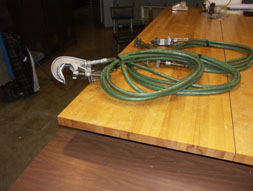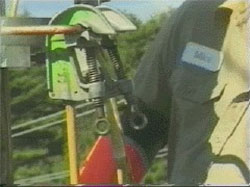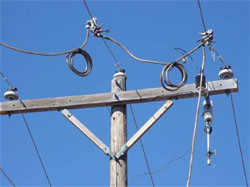Electric Power Generation, Transmission, and Distribution eTool
Hazardous Energy Control » Portable Grounding Equipment

Portable grounding cables and clamps must be able to carry and withstand the maximum fault current available for the time needed for an overcurrent device to trip. The amount of available fault current needs to be determined; depending on the amount, two or more leads in parallel may need to be installed. See 1910.269(n)(4).
Each grounding cable installed on transmission and primary voltage distribution systems must be at least a #2 copper (or equivalent).
On secondary voltage systems (600 volts and less), ground leads must be sized so that they are larger than the conductor and have an impedance low enough so that the operation of any protective device is not delayed. For guidance, see CPL 02-01-038, Appendix B, Item 11.

Clamps and Cables
The clamps on ground leads are a critical component and are much larger than common distribution connectors (such as hotline clamps or bolted connectors) due to the large amount of current that needs to be carried. Some critical factors to consider are:
- The shape of the clamp must be compatible with the shape of the conductor to get the most contact surface and lowest resistance (for example, a clamp designed for use on a round conductor should not be used on a flat bus bar). This will also help keep the connection in place when heavy fault current flows.
- Cables should be as short as possible to reduce "whipping" when fault current is carried and to reduce the weight of the leads. Whipping can result in sufficient force to dislodge or damage the cables or clamps if the circuit becomes energized. If short cables are not available, then the cables should be tied or lashed securely.
-
The connection between the ground cable and the clamps on either end should be inspected periodically to ensure they are in good condition. The cable should be inspected for damage and defects.

- Protective grounds are only as effective as their proper installation, including clean connection points, tight connections, and adequate cable and clamp size and rating.
Equipotential Zone
Grounding for Employee Protection
Protective Grounding and Bonding
Insulating Protective Equipment (IPE)

